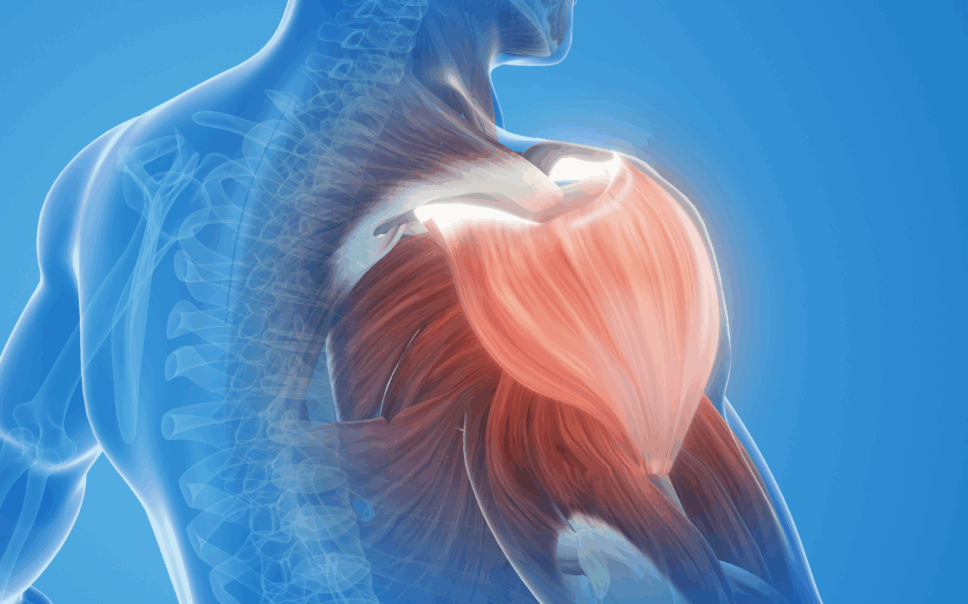Athletes push their bodies to the limit, and the shoulder often takes the brunt of it. Whether it’s throwing a fastball, tackling an opponent, crashing on the singletrack trail, or taking a hard fall on the slopes, the shoulder’s extreme mobility makes it vulnerable to injury. Some of these injuries are minor setbacks, while others can sideline an athlete for months. Knowing what’s serious, what’s not, and how to recover properly can make all the difference in getting back to peak performance.
Rotator Cuff Tears
The Wear-and-Tear Injury That Won’t Be Ignored If you’ve ever felt a sharp pain lifting your arm or struggled to throw with the same force, your rotator cuff might be trying to tell you something. Made up of four small but critical muscles, the rotator cuff stabilizes the shoulder joint and allows for smooth, controlled movement. In sports that involve repetitive overhead motion—baseball, swimming, tennis—these tendons endure a lot of stress. Over time, the strain can lead to inflammation, fraying, and eventually a tear.
Some athletes can manage a minor tear with rest, physical therapy, and anti-inflammatory treatments, allowing them to continue training with modified movements. But when a tear becomes significant, causing persistent weakness or limiting motion, surgical repair may be necessary. The good news? Advances in arthroscopic rotator cuff repair mean less downtime and a more predictable recovery, helping athletes regain full strength and mobility.
Shoulder Dislocations and Instability
When the Joint Won’t Stay Put There’s no mistaking a shoulder dislocation—it’s painful, immediate, and impossible to ignore. A hard hit in football, an awkward fall in wrestling, or a bad landing in gymnastics can all force the humerus (upper arm bone) out of the socket. First-time dislocations are treated by carefully repositioning the joint (a process called reduction) and stabilizing it in a sling. But once a shoulder has dislocated, the risk of it happening again skyrockets.
For some, physical therapy is enough to strengthen the surrounding muscles and restore stability. But for athletes with chronic instability, where the shoulder feels loose or continues to slip out of place, surgery may be the best long-term solution. A stabilization procedure, such as labral repair +/- remplissage procedure or a Latarjet procedure, can reinforce the joint and prevent further dislocations—key for contact sports where a weak shoulder is a liability.
Labral Tears
The Injury You Can’t See But Definitely Feel Inside the shoulder socket, a ring of cartilage called the labrum helps stabilize the joint. But when it tears—either from a dislocation, repetitive throwing, or heavy lifting—the shoulder can feel unstable, weak, or painful during certain movements. Labral tears come in different varieties, but SLAP tears (common in overhead athletes like pitchers and weightlifters) and Bankart lesions (often from dislocations) tend to be the biggest disruptors.
Some labral tears respond well to conservative treatment—rest, strengthening exercises, and possibly an injection to reduce inflammation. But for athletes who need full strength and stability to perform, an arthroscopic labral repair might be necessary to restore function. The key to success is early intervention. Ignoring the problem and pushing through the pain can lead to long-term instability, making future injuries even harder to recover from.
AC Joint Injuries
The Shoulder “Separation” That’s Not a Dislocation It’s easy to confuse an AC (acromioclavicular) joint injury with a dislocated shoulder, but they’re entirely different problems. An AC joint injury—often caused by a direct hit to the shoulder (think: football tackles, cycling crashes, or falls onto the shoulder in skiing or snowboarding)—occurs when the ligaments holding the collarbone to the shoulder blade are stretched or torn. The result? Pain, swelling, and in more severe cases, a visible bump at the top of the shoulder.
Mild AC joint injuries typically heal with rest, ice, and gradual rehab. More severe cases, where the collarbone has shifted significantly out of position, may benefit from surgical reconstruction to realign the joint. The key takeaway? If your shoulder looks deformed after an injury, it’s worth getting evaluated sooner rather than later.
Getting Back in the Game
Shoulder injuries are a reality in sports, but they don’t have to be career-ending. The most important factor in recovery is early diagnosis and proper treatment—whether that means targeted physical therapy, injections, or, in some cases, surgery. Pushing through pain or delaying treatment only increases the risk of long-term damage.
For athletes who rely on their shoulders for peak performance, taking injuries seriously and following a structured recovery plan is the best way to ensure they return to their sport stronger, more stable, and ready for whatever comes next.
Call us today at 907-771-3500 to schedule your appointment.


